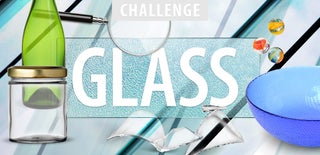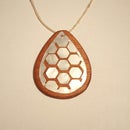Introduction: Firecracker Pots - Exploded Clay
In this Instructable I will be showing you how to create blocks of clay blown up by firecrackers, then glazed and filled with glass. My inspiration for these comes from an American sculptor named Steve Tobin who created this process with his series of art called “Exploded Earth”.
The materials and processes are incredibly simple, and anyone with a simple clay working class at their school or simple home workshop for pottery should easily be able to do this.
Materials
• Clay
• Frit (glass chunks or powder)
• Pottery Glazes
Tools
• Fire crackers
• Anything to give texture
• Kiln
Now a quick disclaimer: Please be careful if you attempt this, and make sure you are under proper supervision when using explosives. Also make sure that fireworks are legal wherever you live and use common sense and proper precautions when using them.
Step 1: Making Clay “Blanks”
On two of them, I coated the entire outside in about pea sized chunks of glass, because when they melt they give a really cool texture (there will be more details later). On the last one, I mixed the same sized glass chunks into this one, just to see how it might affect the end result when the glass pieces melt in the kiln.
Step 2: Blowing Them Up!
This is quite a random process in that you don’t have much control over what the explosives do, however I do have a couple of pointers I learned while doing these. First, depth does matter quite a lot, and you will have to experiment by yourself because you will have different strength firecrackers than me, and your clay won’t be the same viscosity as mine. I found if I pushed a firecracker level with the top, it would create a hollow cavity in the clay, with a hole that is about an inch in diameter on the top (you should clearly be able to find the one I kept like this in the pictures). To get the exploded look like most of the ones I have, you have to keep it out around a quarter of an inch or so. If you accidentally put one too deep and you get the cavity I mentioned above, you can drop another firecracker in, and light it, and the explosion will blow out the edges to get the other look.
After they are blown up, bring them inside and cover them loosely in plastic to prevent them from drying out too quick and cracking, but make sure not to break off any fragile edges.
Step 3: Glazing and Adding Glass Powder (Frit)
For anyone who is interested, the technical specs and thorough descriptions are below, and correlate to the image above. All of the cone 5 pots listed below were filled with a clear frit, and the colors in some of the glass comes from different minerals leaching out from the glazes.
Cone 5:
1. I used Duncan SY1024 Antique Pewter Glaze on this one
The glass turned a greenish tint in this one, and I really like the final outcome of this
2. I used Duncan SY1024 Antique Pewter Glaze on this one too
This pot had the glass chunks mixed in with the clay when it was blown up, so it has a unique texture on the outside from the exposed glass chunks in the clay melting and running down the pot.
3. I used Spectrum 1198 Oil Spot on one with Spectrum 1106 Crimson on the inside
The oil spot didn’t turn out exactly how expected, and looked more like the Pewter glaze. I absolutely love the texture on this pot, because it initially had a woven texture, but the glaze filled that in and gave it the texture of hammered metal.
4. I used Amaco’s Saturation Gold on this one, which ideal would become metallic silver and gold
This also didn’t turn out as expected, and also looks a lot like the Pewter. The blown up edges are a bit gold, and these are also gold tints on the raised edges of the wood grain, but most interestingly, this glaze turned clear frit into a super deep blue color, which really looks awesome.
5. I put Spectrum 1106 Crimson in the cracks of one and all in the inside of the explosion cavity too
I got glaze in the cracks by covering the whole thing in glaze, then wiping off all of the high spots with a wet sponge. The white is just exposed porcelain clay, and this one is definitely one of my favorites.
6. I put Spectrum 1106 Crimson in the interior of this one, and the outside is all glass
The outside is glass, because it was one of the two blanks that I had coated the outside with glass chunks before I blew them up. I knew it would create a really cool texture once they were put in the kiln and melted. The resulting effect is a smooth but slightly pointy feel on the outside, with a very bumpy and prickly texture underneath the tick coat of glass (probably a 1/8th inch layer of glass on the outside covering the rough texture).
7. I put Amaco Underglazes Electric Blue in the interior of this one, and the outside is all glass like the last one
This one was created using the same technique as the one above, with a coating of glass on the outside before it was blown up The clear glass on this one picked up a very deep blue color from the underglaze, and I love the contrast between the white and the dark blue on this piece.
Cone 01:
8. I used a custom made “Lava Slip” with a custom “Phat White” on top, and filled it with red glass.
This one had a very lumpy texture to start, so I figured it would be best suited to the design I had planned. The lava slip bubbles when it is fired, so it creates a really cool lava effect when mixed with the phat white, so I added the red frit inside to create a volcano style piece. I was really, really satisfied with the way this one turned out, and it was even better than I had planned.
Step 4: Final Thoughts
If you like this project, please vote for me in the contests this is submitted into, and also check out my other Instructables!
Thank you!
Brandon (16)

Participated in the
Glass Challenge 2017











